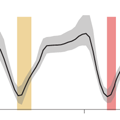Abstract
Background: RNA viruses evolve extremely quickly, allowing them to rapidly adapt to new environmental conditions. Viral pathogens, such as influenza virus, exploit this capacity for evolutionary change to persist within the human population despite substantial immune pressure. Understanding the process of adaptation in these viral systems is essential to our efforts to combat infectious disease.
Results: Through analysis of simulated populations and sequence data from influenza A (H3N2) and measles virus, we show how phylogenetic and population genetic techniques can be used to assess the strength and temporal pattern of adaptive evolution. The action of natural selection affects the shape of the genealogical tree connecting members of an evolving population, causing deviations from the neutral expectation. The magnitude and distribution of these deviations lends insight into the historical pattern of evolution and adaptation in the viral population. We quantify the degree of ongoing adaptation in influenza and measles virus through comparison of census population size and effective population size inferred from genealogical patterns, finding a 60-fold greater deviation in influenza than in measles. We also examine the tempo of adaptation in influenza, finding evidence for both continuous and episodic change.
Conclusions: Our results have important consequences for understanding the epidemiological and evolutionary dynamics of the influenza virus. Additionally, these general techniques may prove useful to assess the strength and pattern of adaptive evolution in a variety of evolving systems. They are especially powerful when assessing selection in fast-evolving populations, where temporal patterns become highly visible.
